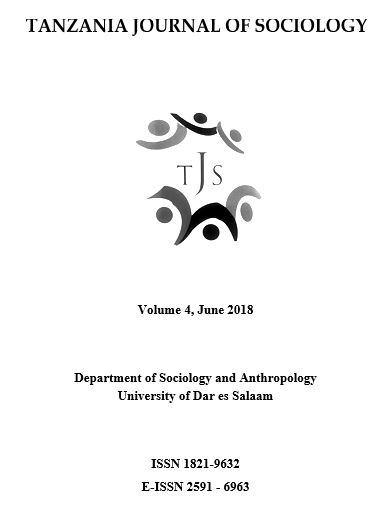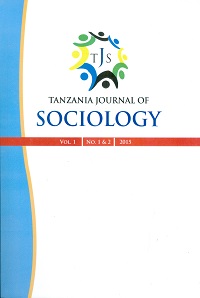The Social Basis for Patient-Female Nurse Misunderstandings: Reflections from Muleba and Chato Districts
Abstract
Recent studies in Tanzania have revealed the nature and magnitude of patients ' abuse and neglect under maternity care. However, the question of female nurses as main perpetrators of such misconducts has not been addressed. Quantitative data collected from systematically sampled health care users and qualitative data generated through in-depth interviews with healthcare providers in Chato and Muleba districts were used to explain the uneasy relations between patients and female nurses. The findings revealed that abusive nurses are mainly female nurses, perceived by patients as uncaring and less compassionate than their counterpart male nurses who are caring and empathetic. Viewed using the lenses of symbolic interactionism, such abusive behaviours displayed by female nurses are responses to patients ' demeaning behaviours of regarding female nurses as a weak category of health providers in terms of their expertise and professional skills. Additionally, female nurses, who also occupy inferior social positions like other women, use medical power embodied in the control of medical information to elevate their gender position in medical settings and wider social settings, but in the process of achieving this goal they abuse patients. Any efforts to improve patient-female nurse relations need to consider women ' s position in general social settings and medical settings.
References
Aguilera, D. 1967. Relationship between physical contact and verbal interaction between nurses and patients. Journal of psychiatry Nurse Management Health Service; vol. 5, pp. 5-21.
Andersen, H. 2004. Villagers: Differential treatment in a Ghanian hospital. Social Science and Medicine; Vol. 59, pp. 2003-2012.
Bernard, R.2006. Research methods in anthropology: qualitative and quantitative approaches. UK: AltaMira Press.
Davies, P. 1994. Non-verbal communication with patients. British Journal of Nursing; Vol. 3, pp. 303-310.
Fisher, C.1983. "Doctor talk/patient talk: how treatment decisions are negotiated in doctor-patient communication" in Fisher and A. Todd (eds) The Social Organization of Doctor-Patient Communication, pp.135 €“ 157. NJ, Ablex Norwood.
Fleischer, S., Berg, A., Zimmermann, M., Wuste, K. & Behrens, J. 2009. Nurse patient interaction and communication: A systematic literature review. Journal of Public Health; Vol. 17, pp. 339-353.
Freud, S.E and McGuire, M.999. Health, illness, and the social body: a critical sociology. New Jersey: Prentice-Hall Inc.
Gino, F. and Brook, A.2015). Explaining gender difference at the top - Harvard Business Review. Available from: https://hbr.org/2015/09/explaining-gender-differences-at-the-top. [19 October 2017].
Global Publisher.2016. Kituo cha Afya Mbagala Chalalamikiwa. Available from: https://globalpublishers.co.tz/kituo-cha-afya-mbagala-chalalamikiwa [17 May 2016]
Habari Leo.2009. "Daktari Achunguzwa kwa Kifo cha Kichanga", Available from: http://www.bongo5.com/content/view/3499/232/lang,en/. [13 September 2009].
Hughes, J. 1996. The doctor-patient relationship: does it really matter? Available from: ieet.org/index.php/IEET/more/hughes19960229/. [5 February 2009].
Jamiiforums. 2017. Kero: Wahudumu wa hospitali zetu mnakera sana kwa kutokujua kuhudumia na kutimiza wajibu wenu. Available from: https://www.jamiiforums.com/threads/kero-wahudumu-wa-hospitali-zetu-mnakera-sana-kwa-kutokujua-kuhudumia-na-kutimiza-wajibu-wenu.1317723/#post-23488963. [11 September 2017].
Jamiiforums. 2016. Manesi wana dharau sana. Available from: https://www.jamiiforums.com/threads/manesi-wana-dharau-sana.1304309/page-2#post-22961497. [11 September 2017].
Jewkes, R; Abrahams, N and Mvo, Z .1998. Why do nurses abuse patients? Reflections from South African obstetric services. Social Science and Medicine; Vol 47. pp.1781- 1795.
Kamugisha, G. 2014. The influence of healthcare reforms on patient-health provider relationships in Chato and Muleba Districts. Tanzania Journal of Population Studies and Development; Vol. 21, pp. 107-120.
Kujawski S., Mbaruku, G., Freedman L.P., Ramsey, K., Moyo, W., Kruk, M.E. 2015. Association between disrespect and abuse during childbirth and women ' s confidence in health facilities in Tanzania. Maternal and Child Health Journal, Vol. 19,, pp. 2243 €“2250.
Mamdani, M. and Bangser, M. 2004. Poor people's experiences of health services in Tanzania: A Literature review. Reproductive Health Matters; Vol 12, pp. 138-153.
McMahon, S; George, A.S; Chebet, JJ; Mosha, IH; Mpembeni, RN; Winch, PJ. 2014.. Experience of and responses to disrespectful maternity care and abuse during childbirth; a qualitative study with women and men in Morogoro Region, Tanzania. BMC Pregnancy Childbirth; Vol. 14, pp. 1 €“ 13.
Mhondwa, E.P.Y; Leshabari, M.T; Mwangu, M; Mbembati, N; Ezekiel, M.J. 2008. Patient satisfaction at the Muhimbili national hospital in Dar es Salaam, Tanzania. East African Journal of Public Health; Vol. 5, pp. 67 €“ 73.
Mliga, R. 2003. "Decentralization and the quality of health care in Tanzania" In David K. L (ed) Africa ' s Changing Markets for Health and Veterinary Services, University of California Press, California.
Mwananchi. 2009. Madaktari Amana Wadaiwa Kusababisha Kifo cha Mjamzito. Available from http://www.mwananchi.co.tz/newsrids.asp?id=11161. [13 July 2009].
Ousey, K and Johnson, M. 2007. Being a real nurse €“ concepts and culture in the clinical area. Nurse Education in Practice; Vol. 7, pp. 150 €“ 155.
Poter, S. 1992. The poverty of professionalization: a critical analysis of strategies for the occupational advancement of nursing. Journal of Advanced Nursing; Vol. 17, pp. 679 €“ 684.
Sando D., Kendall, T., Lyatuu, G., Ratcliffe, H., McDonald K, Mwanyika-Sando M, Emil F, Chalamila G, Langer A. 2014. Disrespect and abuse during childbirth in Tanzania: Are women living with HIV more vulnerable?. Journal of Acquired Immune Deficiency Syndromes; Vol. 67; pp. 228 €“234.
Tibandebage, P. and Mackintosh, M. 2005. The market shaping of charges, trust and abuse: health care transactions in Tanzania; Social Science & Medicine; Vol. 61, pp. 1385-1395.
The African news paper .10th June 2009. Suggestion Boxes to be Used to Expose Rude Nurses.
Tibaijuka, A.K. 1998. "Trends and issues in health service delivery under economic adjustment"in Tibaijuka, A.K (ed) The Social Service Crisis of the 1990s: Strategies for Sustainable Systems in Tanzania. Ashgate Publishing Ltd, England.
United Nations Development Programme (2016). Human Development Report.
United Republic of Tanzania. 1990. National Health Policy.
United Republic of Tanzania. 2000. Health Sector Reforms. Available from: http://www.tanzania.go.tz/health.html. [9 February 2009].
United Republic of Tanzania. 2005. Health Services in Tanzania. Available from: http://www.moh.go.tz/health%20services.php. [11February 2009].
United Republic of Tanzania. 2006. Annual Health Statistical
Abstracts Tanzania Mainland 2006. Health Information and Research Section, Department of Policy and Planning.
United Republic of Tanzania. 2013. Human resource for health €“ country profile 2012/2013.
United Republic of Tanzania. 2008. Annual Health Statistical Abstracts Tanzania Mainland 2008. Health Information and Research Section, Department of Policy and Planning.
United Republic of Tanzania. 2009. Health facilities. Available from: http://www.moh.go.tz/health%20facilities.php. [13 July 2017].
United Republic of Tanzania. 2013. Ministry of health and social welfare. Human resource for health €“ country profile 2012/2013.
United Republic of Tanzania. 2014. Ministry of health and social welfare. Human resource for health €“ country profile 2013/2014.



